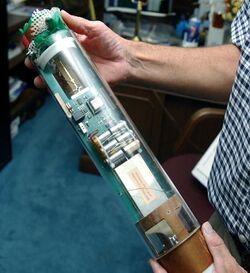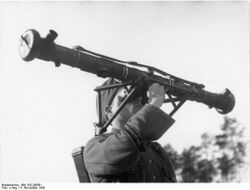Astronomy:Telemeter
The original meaning of telemeter (Ancient Greek: τῆλε tēle "far away" and μέτρον métron "something used to measure"), and still one of the main uses of the word, was a device used to measure distances to remote objects, that is, a rangefinder. Originally optical devices used in surveying, they soon found military applications in rangefinding, especially naval gunnery and anti-aircraft artillery.
Another meaning of telemeter is a device used to remotely measure any quantity. It consists of a sensor, a transmission path, and a display, recording, or control device. Telemeters are the physical devices used in telemetry. Electronic devices are widely used in telemetry and can be wireless or hard-wired, analog or digital. Other technologies are also possible, such as mechanical, hydraulic and optical.[1]
History
The first rangefinder telemeter was invented by James Watt in 1769 and put to use in 1771 in surveying canals. Watt called his instrument a micrometer, a term now used with a different meaning in engineering. It consisted of two parallel hairs in the focal plane of a telescope eyepiece crossing an upright hair. At the point to be measured, two sliding targets on a surveyor's rod were adjusted to align with the hairs in the telescope. The distance to the rod could then be determined from the distance between the targets on the rod by trigonometry.[2]
Several others have been credited with the invention of the rangefinder telemeter at one time or another. The Royal Society of Arts gave an award to W. Green for its invention in 1778, even though they were made aware of Watt's priority.[3]
In 1778 Georg Friedrich Brander invented the coincidence telemeter. Two mirrors set a distance apart horizontally in a long slim box, similar to a subtense bar but located at the measuring station, and forming two images. This rangefinder does not require a measuring rod at the target and could perhaps be considered the first true telemeter. In 1790 Jesse Ramsden invented a half-image range finder. Alexander Selligue is often mistakenly credited with the invention, he did invent an improved telemeter with fixed lenses in 1821 and is responsible for coining the term.[4][5]
In 1899 Carl Pulfrich at Carl Zeiss AG fabricated a practical stereoscopic rangefinder[6], based on a patent of Hector Alexander de Grousilliers[7].

Kopp places the beginning of industrial telemetry in the steam age, although the remote sensor was not called telemeter at that time. Examples are James Watt's (1736-1819) additions to his steam engines for monitoring from a (near) distance such as the mercury pressure gauge and the fly-ball governor.[8]
By the late 19th century the term had been thoroughly hijacked by electrical engineers applying it to electrically operated devices measuring many other quantities besides distance.[9] These included such sensors as the thermocouple (from the work of Thomas Johann Seebeck), the resistance thermometer (by William Siemens based on the work of Humphry Davy), and the electrical strain gauge (based on Lord Kelvin's discovery that conductors under mechanical strain change their resistance) and output devices such as Samuel Morse's telegraph sounder and the relay. In 1889 this led the Institution of Civil Engineers to suggest that the term for a rangefinder be replaced with tachometer.[10]
In the 1930s use of electrical telemeters grew rapidly. The electrical strain gauge was widely used in rocket and aviation research and the radiosonde was invented for meteorological measurements. The advent of World War II gave an impetus to industrial development and henceforth many of these telemeters became commercially viable.[11]
Carrying on from rocket research, radio telemetry was used routinely as space exploration got underway. Spacecraft are in a place where a physical connection is not possible, leaving radio or other electromagnetic waves (such as infrared lasers) as the only viable option for telemetry. During manned space missions it is used to monitor not only parameters of the vehicle, but also the health and life support of the astronauts.[12] During the Cold War telemetry found uses in espionage. US intelligence found that they could monitor the telemetry from Soviet missile tests by building a telemeter of their own to intercept the radio signals and hence learn a great deal about Soviet capabilities.[13]
Rangefinding
In military parlance telemeter has the specific meaning of a device for finding the range of a target. It is also used with the meaning "rangefinder" in other fields such as photography. World War II era telemeters worked optically with two telescopes focused on the same target but a distance apart along a baseline. The range to the target is found by measuring the difference in bearing of the two telescopes and solving the skinny triangle. Solutions can be obtained automatically, using tables or, rarely, manual calculation. The greater the distance to the target, the longer the baseline needs to be for accurate measurement. The baseline required for the telemeters for battleship guns is very large. More modern telemeters use an electronic technology such as lasers or radar.
Telemeter chronograph
The telemeter chronograph is a feature of a wristwatch, which allows the user to approximately measure the distance to an event that can be both seen and heard (e.g. a lightning bolt or a torpedo strike) using the speed of sound. The user starts the chronograph (stopwatch) at the instant the event is seen, and stops timing at the instant the event is heard. The seconds hand will point to the distance measured on a scale, usually around the edge of the face. The scale can be defined in any unit of distance, but miles or kilometers are most practical and commonplace.[14]
See also
- GfK-Telemeter, a device to determine the viewing rate
References
- ↑ Bakshi et al., pages 8.1-8.3
- ↑ Dickinson, pages 56, 75-76
- ↑ Dickinson, pages 76-77
- ↑ Johann Gottfried Dingler, Polytechnisches Journal, vol. 8, page 121, Stuttgart: Cotta 1822 OCLC 183328327 (in German)
- ↑ A. Rittig von Flammenstern, Archiv für Geographie, Historie, Staats- und Kriegskunst, vol. 13, Franz Härter: Wien, page 561 (in German)
- ↑ Deumlich, page 15
- ↑ Hector Alexander de Grousilliers, "Improved Stereoscopic Telemeter.", GB patent 189317048, issued 1894-07-14
- ↑ Kopp, page 494
- ↑ Fernando J. Dibble, "Electric Telemeter Transmitter.", US patent 490012, issued 1893-01-17
- ↑ Minutes of Proceedings of the Institution of Civil Engineers, volume 95, part 1, page 207, Institution of Civil Engineers (Great Britain) 1889.
- ↑ Kopp, page 497
- ↑ Tsiao, pages xxxii-xxxiii
- ↑ MacKenzie, page 235
- ↑ http://www.chronomaster.co.uk/telemeter_chronograph.htm
Bibliography
- H. W. Dickinson, James Watt: Craftsman and Engineer, Cambridge University Press, 2010 ISBN:110801223X.
- Fritz Deumlich, Surveying Instruments, Walter de Gruyter, 1982 ISBN:3110077655.
- Brian Kopp, "Industrial telemetry", in Telemetry Systems Engineering, pages 493-524, Artech House, 2002 ISBN:1580532578.
- K.A.Bakshi A.V.Bakshi U.A.Bakshi, Electronic Measurements, Technical Publications, 2008 ISBN:8184313918.
- Richard Shelton Kirby, Engineering in History, Courier Dover Publications, 1990 ISBN:0486264122.
- Donald MacKenzie, "The Soviet Union and strategic missile guidance", in Soviet Military Policy: An International Security Reader, MIT Press, 1989 ISBN:0262620669.
- Sunny Tsiao, Read You Loud and Clear: The Story of NASA's Spaceflight Tracking and Data Network, Government Printing Office, 2008 ISBN:0160801915.



